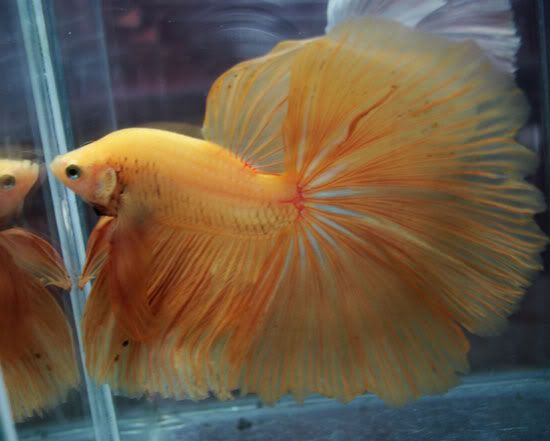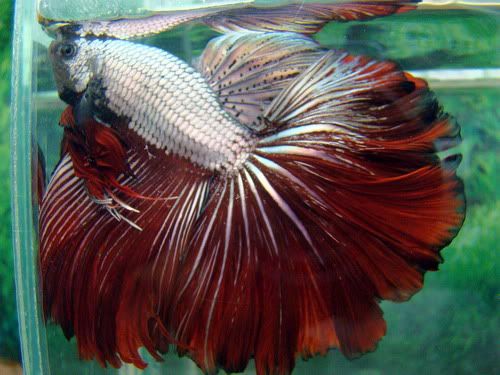- tail very long, the longer the better
- has to have desirable HM form, e.g. 180 degree, large dorsal (not bent!), large and squarish anal
- no DT gene (or not a direct carrier anyway -- how to know? cross it with an ST with DT carrier, if none of fry is DT then we're good)
- round circle connecting caudal, dorsal, and anal
- 8, 16, or 32 rays branching, as long the fin is fully expanded and show off beautifully
- little or none rosetail gene (misalignment of scales, fin ruggerized)
If possible, the caudal length is as long as the fish's body, if not longer.
Now, many would complain that the betta would look like "dragging" its tail....Well, no...majority would be, since that's not "good health" bettas. Good bettas would show off the tail very nicely and flare actively without much of dragging. Only old or weak bettas will drag their tail. Unfortunately, finding such a betta is very difficult, since you have to rely on your eyes to spot the right pictured one.
Due to the above weaknesses, many breeders have preferred a much shorter tail. Well, that's not something that we fancy. To put it simple, it's easy to produce shorter tail bettas, hence there is not much challenge in it. It's a lot more difficult to produce consistent long and strong tail bettas!
Long tail carries extra problems too...water needs to be extra clean, otherwise finrot will just crop up like bush fire. fry needs early separation as you definitely dont want that beautiful long tail torn to pieces.
We'll find more pictures on what the bettas would look like, but if you check our previous posts, you'll find some of them (copper pictures here and here for instance). They are very beautiful when flare and the way they move....
Here are examples (permission given by seller):


Note that there are more improvements for the above 2 pictures such as dorsal/anal areas, however the point of discussion at the moment is the caudal. Also, we don't know if any of these 2 fish "drag" their caudal or not, cause the static pics don't show that. However, given their apparent agressive outlook, we can assume that they're okay....
Here is another example of large tail, accompanied by large body. This fish seems old as well (and well fed ;). It is confirmed that this one carries DT as indicated by the volume of the tail. Not sure if the above 2 fish carry DT, but suspect they are.

Interestingly, the larger the finnage, the more chance of heavy branchings happening, hence the more chance of feathertail occuring. Nothing wrong with this, in fact it looks even nice as it indicates the beautiful branchings on their tail (we've start off with 1 or 2 branchings on typical bettas to 16 or 32 branches, even up to 64 branches). As long they don't form extreme rosetail, they just look nice, don't you agree?




No comments:
Post a Comment
Please do not put your email address on the comment to avoid being mined by spambot. Comment on posts older than a month will go through moderation (to avoid spam). Comments will not be filtered in any way - you would know, wouldn't you, cause you leave the comments to begin with :) Thanks for the comments!